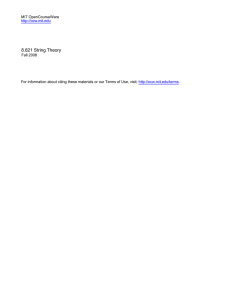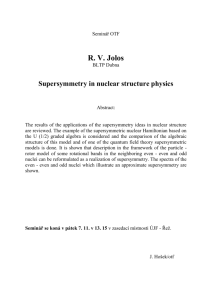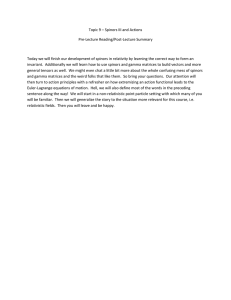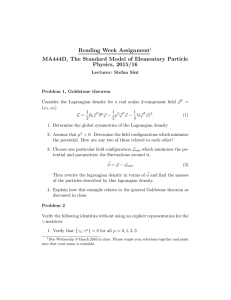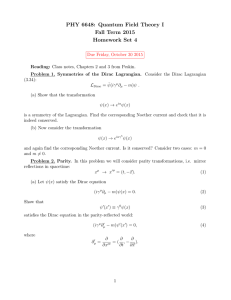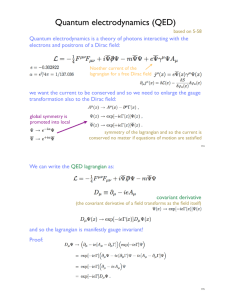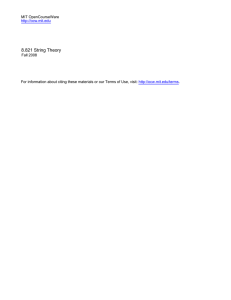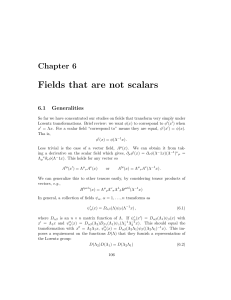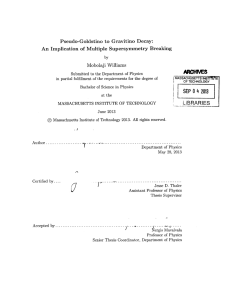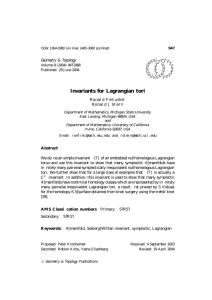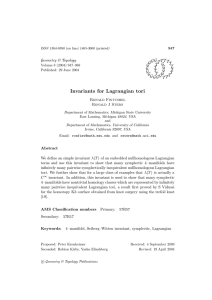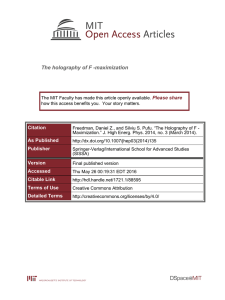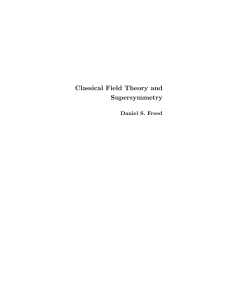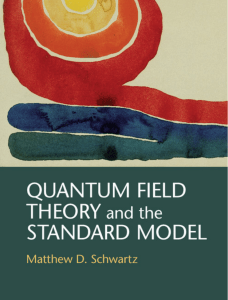MASSACHUSETTS INSTITUTE OF TECHNOLOGY Department of Physics
advertisement
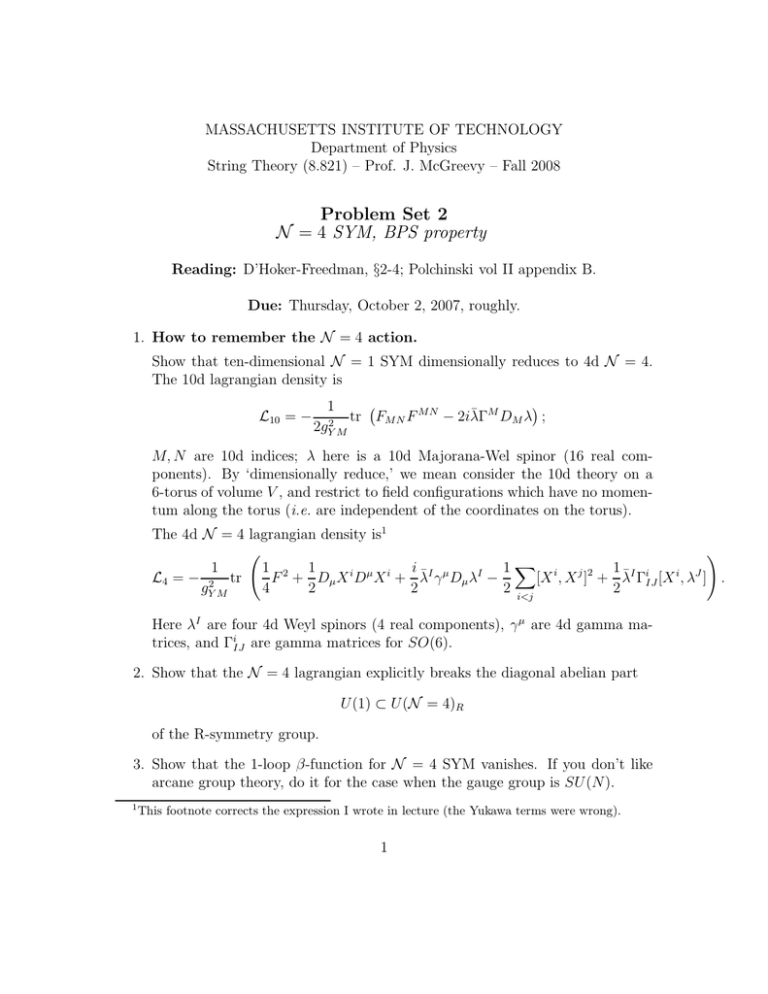
MASSACHUSETTS INSTITUTE OF TECHNOLOGY Department of Physics String Theory (8.821) – Prof. J. McGreevy – Fall 2008 Problem Set 2 N = 4 SYM, BPS property Reading: D’Hoker-Freedman, §2-4; Polchinski vol II appendix B. Due: Thursday, October 2, 2007, roughly. 1. How to remember the N = 4 action. Show that ten-dimensional N = 1 SYM dimensionally reduces to 4d N = 4. The 10d lagrangian density is L10 = − 1 tr FM N F M N − 2iλ̄ΓM DM λ ; 2 2gY M M, N are 10d indices; λ here is a 10d Majorana-Wel spinor (16 real components). By ‘dimensionally reduce,’ we mean consider the 10d theory on a 6-torus of volume V , and restrict to field configurations which have no momentum along the torus (i.e. are independent of the coordinates on the torus). The 4d N = 4 lagrangian density is1 L4 = − 1 gY2 M tr i 1 2 1 F + Dµ X i D µ X i + λ̄I γ µ Dµ λI − 4 2 2 2 Here λI are four 4d Weyl spinors (4 real components), γ µ are 4d gamma matrices, and ΓiIJ are gamma matrices for SO(6). 2. Show that the N = 4 lagrangian explicitly breaks the diagonal abelian part U(1) ⊂ U(N = 4)R of the R-symmetry group. 3. Show that the 1-loop β-function for N = 4 SYM vanishes. If you don’t like arcane group theory, do it for the case when the gauge group is SU(N). 1 This footnote corrects the expression I wrote in lecture (the Yukawa terms were wrong). 1 ! 1 [X i , X j ]2 + λ̄I ΓiIJ [X i , λJ ] . 2 i<j 1X 4. N = 4 ⊃ N = 1. A 4d N = 4 supersymmetric theory is a special case of a 4d N = 1 supersymmetric theory. a) Describe the field content of N = 4 SYM in terms of multiplets of some N = 1 subgroup. b) Write the N = 4 lagrangian in N = 1 superspace. c) Convince yourself that this Lagrangian has SO(6) R-symmetry (e.g. by examining the Lagrangian written in components). Is N = 1 supersymmetry plus this R-symmetry enough to convince you that this action is actually N = 4 supersymmetric? 5. Extremal = BPS. In this problem we will consider 4d N = 2 supergravity (which has eight real supercharges). Along the lines of the discussion from lecture 5 one can see that the graviton multiplet for this theory must also contain a spin-3/2 gravitino field ψµ , and an abelian vector field (the ‘graviphoton’) Aµ . So this is a simple supersymmetric completion of the system we studied in problem set 1 problem 3. The action is invariant under supersymmetry transformations which include the following variation for the gravitino ψµ : 1 − δψµ = ∇µ − F γµ ǫ 4 where 1 Fνρ ± (⋆F )νρ 2 are the self-dual (SD) and anti-self-dual (ASD) parts of the field strength of the graviphoton field. The covariant derivative acting on spinors is 1 ab ∇µ ψ ≡ ∂µ + ωµ γab ψ 4 − ν ρ F − ≡ Fνρ γ γ , ± Fνρ = where ω is the spin connection, dea = −ω ab ∧ eb and γab ≡ 12 [γa , γb]. a) Show that the extremal RN black hole from problem set 1 lies in a short (BPS) multiplet of the N = 2 supersymmetry. Do this by examining the supersymmetry variations of the fermionic fields (given above) and showing 2 that they vanish for some choice of spinors ǫ. How many supersymmetries (choices of ǫ, which are called Killing spinors) are left unbroken? b) Show that the ‘Bertotti-Robinson’ solution, i.e. AdS2 × S 2 (which arises as the near-horizon limit of the extremal RN black hole) preserves eight Killing spinors. c) If you are feeling energetic, show that AdS5 × S 5 preserves 32 supercharges of 10-dimensional type IIB supergravity. The supersymmetry variations of the fermion fields in that case are i − δψµ = ∇µ − F Γµ ǫ + ... 1920 5 δλ = ... where F5+ ≡ Γµ1 ...µ5 (F5 )µ1 ...µ5 , λ is the ‘dilatino’ field and ... means terms that vanish when F5 is the only nontrivial field other than the metric (i.e. they depend on derivatives of the dilaton, and the other fluxes). If you want to know what the full variations are, see Kiritsis eqns (H.26-28). 6. W-bosons from adjoint higgsing. Using the N = 4 lagrangian, show that giving an expectation value to the scalars in the N = 4 theory of the form hX i=1,...,6 i = diag(xi1 , . . . xiN ) gives a mass to the off-diagonal gauge bosons of the form m2ab ∝ 6 X (xia − xib )2 ≡ |~xa − ~xb |2 ; i=1 this is meant to be the mass of the gauge boson with indices ab. Show that the scalars with the same gauge charges get the same mass. 3
